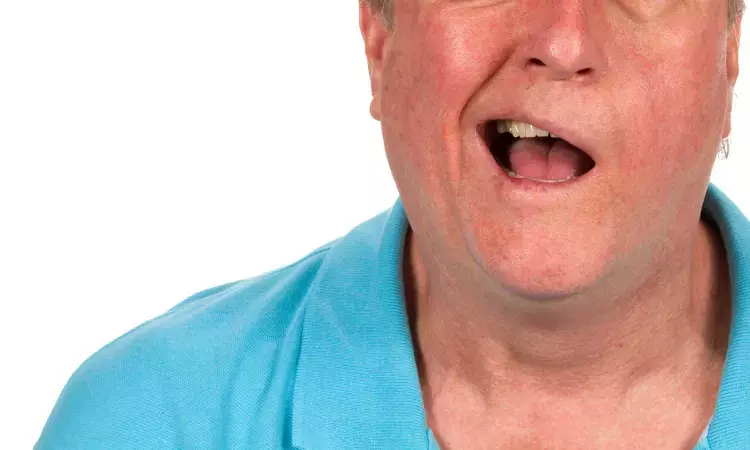- Home
- Medical news & Guidelines
- Anesthesiology
- Cardiology and CTVS
- Critical Care
- Dentistry
- Dermatology
- Diabetes and Endocrinology
- ENT
- Gastroenterology
- Medicine
- Nephrology
- Neurology
- Obstretics-Gynaecology
- Oncology
- Ophthalmology
- Orthopaedics
- Pediatrics-Neonatology
- Psychiatry
- Pulmonology
- Radiology
- Surgery
- Urology
- Laboratory Medicine
- Diet
- Nursing
- Paramedical
- Physiotherapy
- Health news
- Fact Check
- Bone Health Fact Check
- Brain Health Fact Check
- Cancer Related Fact Check
- Child Care Fact Check
- Dental and oral health fact check
- Diabetes and metabolic health fact check
- Diet and Nutrition Fact Check
- Eye and ENT Care Fact Check
- Fitness fact check
- Gut health fact check
- Heart health fact check
- Kidney health fact check
- Medical education fact check
- Men's health fact check
- Respiratory fact check
- Skin and hair care fact check
- Vaccine and Immunization fact check
- Women's health fact check
- AYUSH
- State News
- Andaman and Nicobar Islands
- Andhra Pradesh
- Arunachal Pradesh
- Assam
- Bihar
- Chandigarh
- Chattisgarh
- Dadra and Nagar Haveli
- Daman and Diu
- Delhi
- Goa
- Gujarat
- Haryana
- Himachal Pradesh
- Jammu & Kashmir
- Jharkhand
- Karnataka
- Kerala
- Ladakh
- Lakshadweep
- Madhya Pradesh
- Maharashtra
- Manipur
- Meghalaya
- Mizoram
- Nagaland
- Odisha
- Puducherry
- Punjab
- Rajasthan
- Sikkim
- Tamil Nadu
- Telangana
- Tripura
- Uttar Pradesh
- Uttrakhand
- West Bengal
- Medical Education
- Industry
Cranial Nerve Palsy Linked to Increased Stroke Risk in Young Adults: Study

Researchers have found that cranial nerve palsy (CNP) affecting the third, fourth, or sixth cranial nerve is associated with a higher risk of stroke, particularly among young adults. This association was strongest in individuals in their 30s, suggesting that early detection and monitoring could be crucial for preventing stroke in this demographic. A recent study was published in the Journal of The American Heart Association by Daye Diana Choi and colleagues.
CNP can impact ocular motor function, leading to symptoms such as double vision and difficulty with eye movement. While CNP is often considered a localized neurological issue, emerging evidence suggests that it may also be a marker for broader vascular concerns, including stroke. This study aimed to explore the relationship between CNP and stroke risk, with a focus on how age influences this association.
The cohort study included individuals diagnosed with third, fourth, or sixth CNP who participated in national health screenings within two years of diagnosis between 2010 and 2017. A control group, matched by sex and age at a 1:5 ratio, was used for comparison. Participants were followed until December 31, 2019. Using multivariable Cox proportional hazards regression analyses, the study assessed the risk of stroke associated with CNP, adjusting for covariates such as lifestyle, health behavior, underlying comorbidities, and Charlson comorbidity index scores.
The study included a significant cohort of individuals, with those diagnosed with ocular motor CNP demonstrating a higher risk of stroke compared to the control group (hazard ratio [HR], 1.23 [95% CI, 1.08-1.39]). Notably, the risk of stroke varied significantly with age:
• 30s: The risk of stroke increased by 8.91 times (HR, 8.91 [95% CI, 1.63-48.66]).
• 40s: The risk increased by 2.49 times (HR, 2.49 [95% CI, 1.39-4.45]).
• 50s: The risk increased by 1.78 times (HR, 1.78 [95% CI, 1.31-2.42]).
• 60s: The risk increased by 1.32 times (HR, 1.32 [95% CI, 1.08-1.62]).
• 20s, 70s, and 80s: No significant increase in stroke incidence was observed in these age groups.
The findings underscore a pronounced age-related variation in stroke risk associated with CNP, with the most substantial risk observed in younger adults, particularly those in their 30s. This elevated risk highlights the importance of vigilant cardiovascular monitoring and preventive strategies in younger individuals diagnosed with CNP. The lack of significant risk increase in the very young (20s) and older age groups (70s and 80s) suggests that age-specific factors may modulate the vulnerability to stroke post-CNP diagnosis.
This cohort study establishes a clear association between ocular motor CNP and an elevated risk of stroke, particularly in younger adults. These findings emphasize the need for heightened awareness and preventive measures in patients with CNP to mitigate the risk of stroke.
Reference:
Choi, D. D., Cheon, D. Y., Park, K.-A., Han, K., Jung, J.-H., & Oh, S. Y. (2024). Age‐related risk of stroke following ocular motor cranial nerve palsy. Journal of the American Heart Association, 13(12). https://doi.org/10.1161/jaha.123.033437
Dr Riya Dave has completed dentistry from Gujarat University in 2022. She is a dentist and accomplished medical and scientific writer known for her commitment to bridging the gap between clinical expertise and accessible healthcare information. She has been actively involved in writing blogs related to health and wellness.
Dr Kamal Kant Kohli-MBBS, DTCD- a chest specialist with more than 30 years of practice and a flair for writing clinical articles, Dr Kamal Kant Kohli joined Medical Dialogues as a Chief Editor of Medical News. Besides writing articles, as an editor, he proofreads and verifies all the medical content published on Medical Dialogues including those coming from journals, studies,medical conferences,guidelines etc. Email: drkohli@medicaldialogues.in. Contact no. 011-43720751


